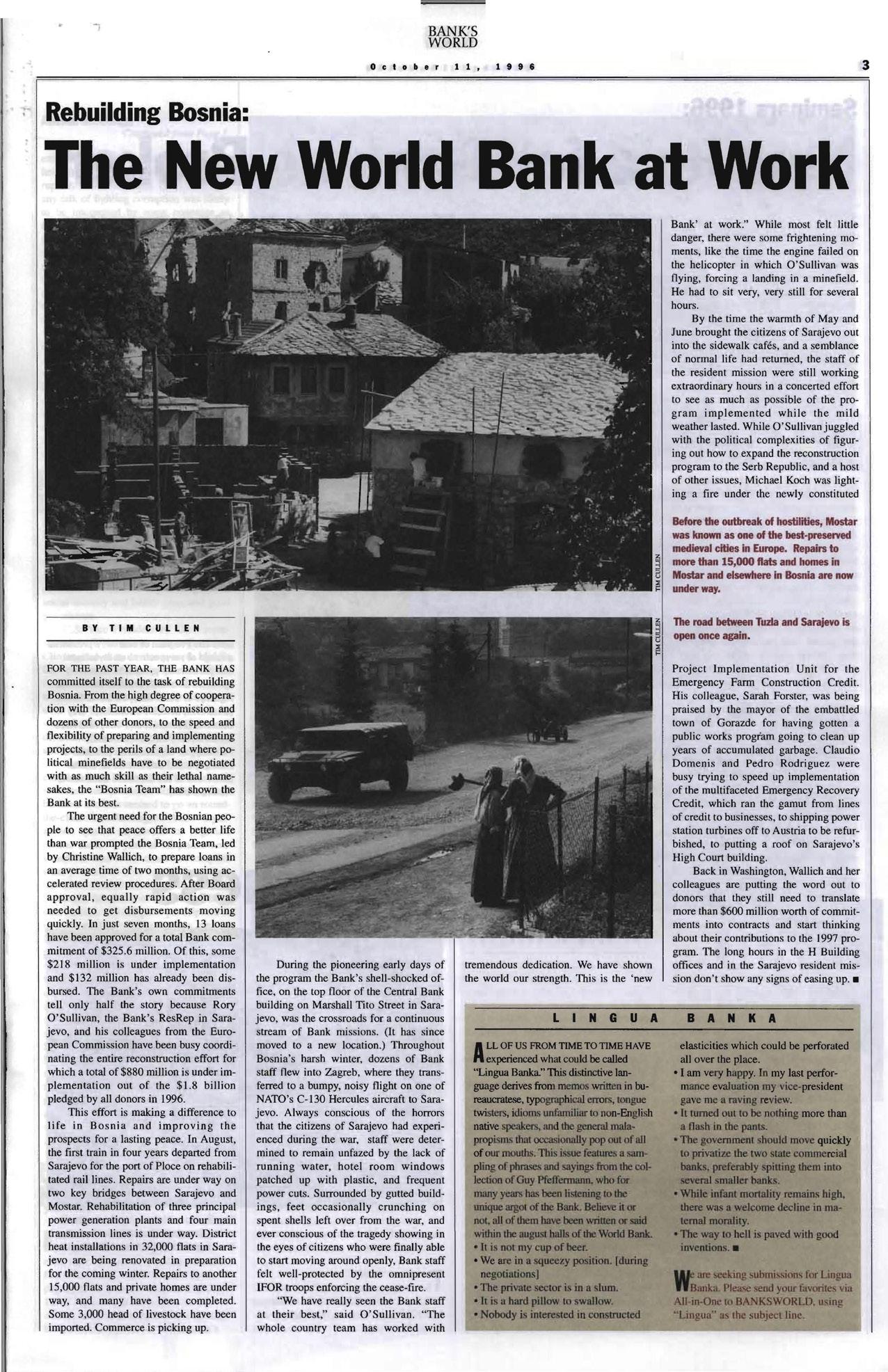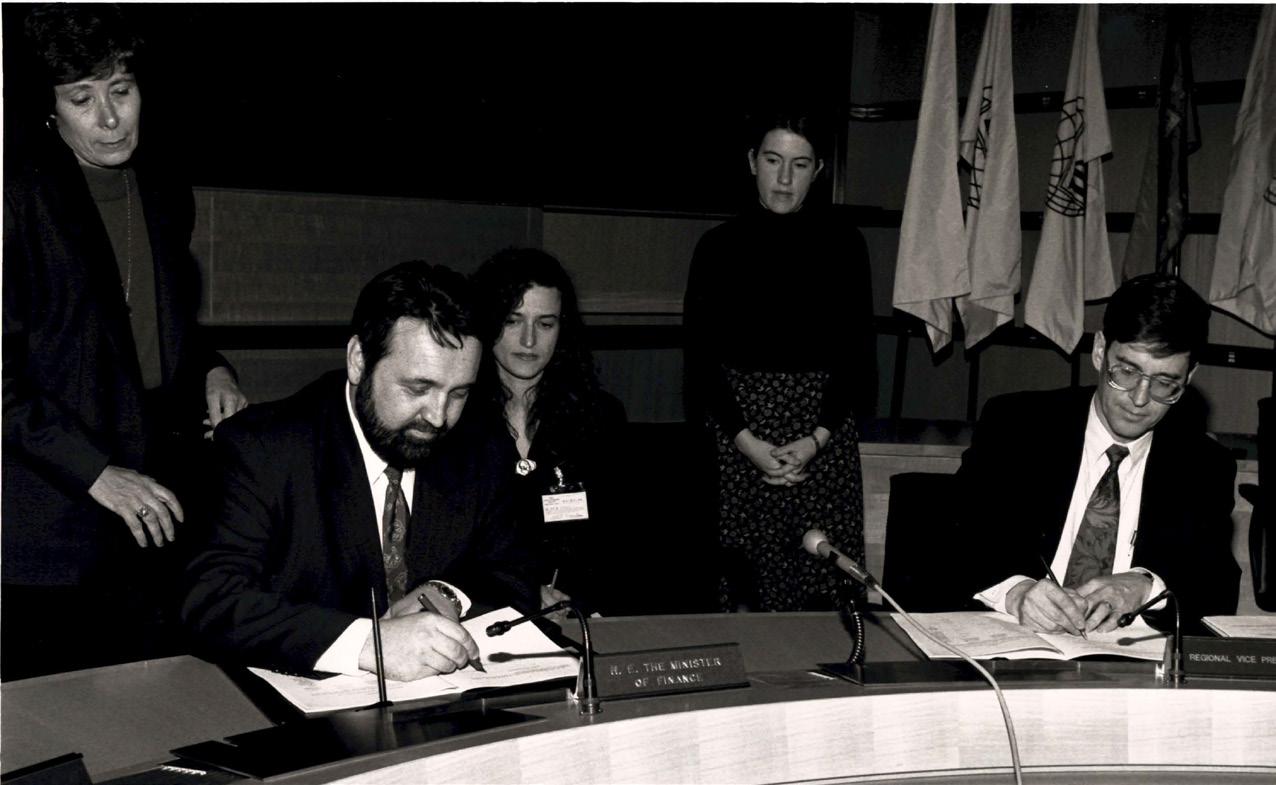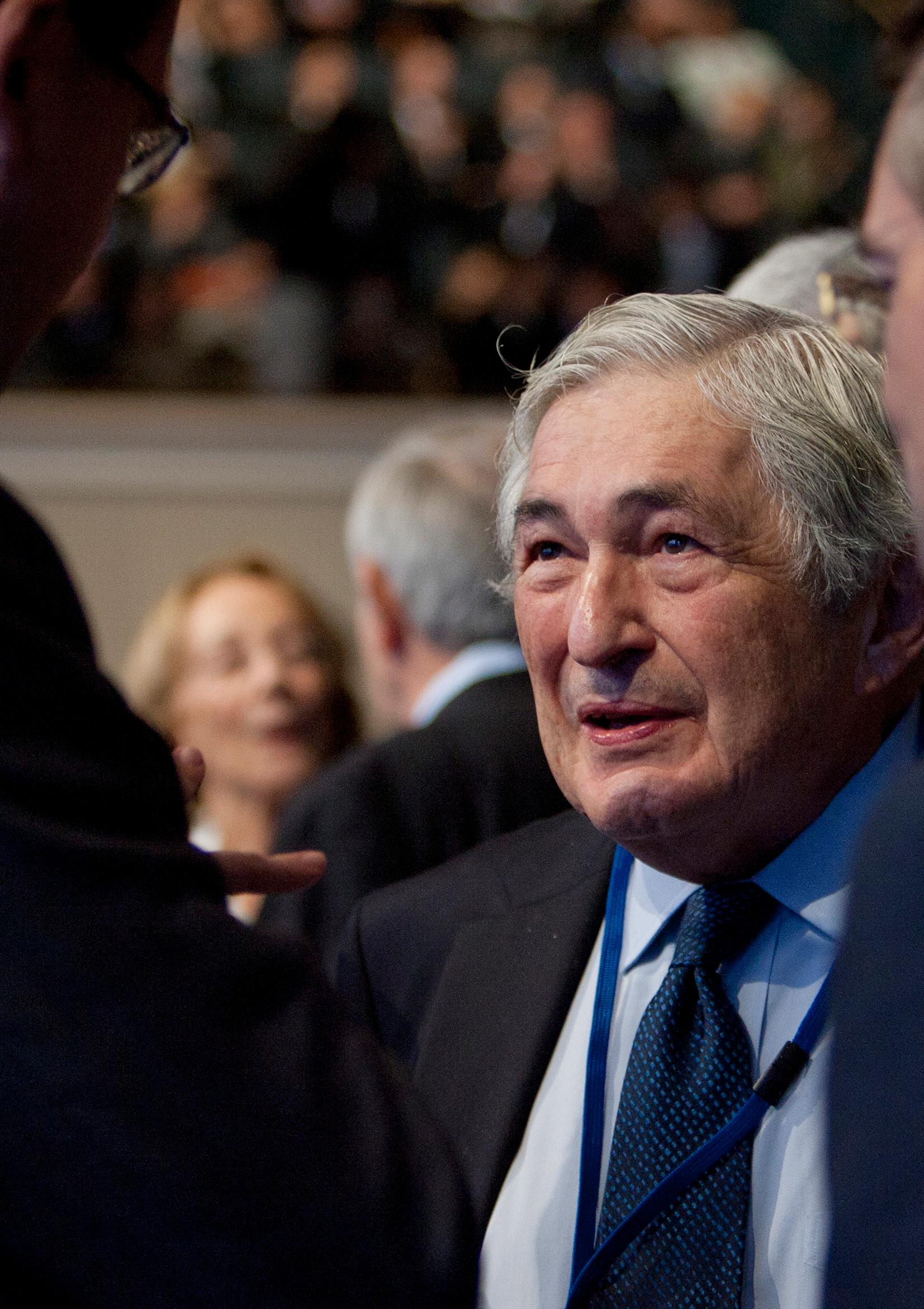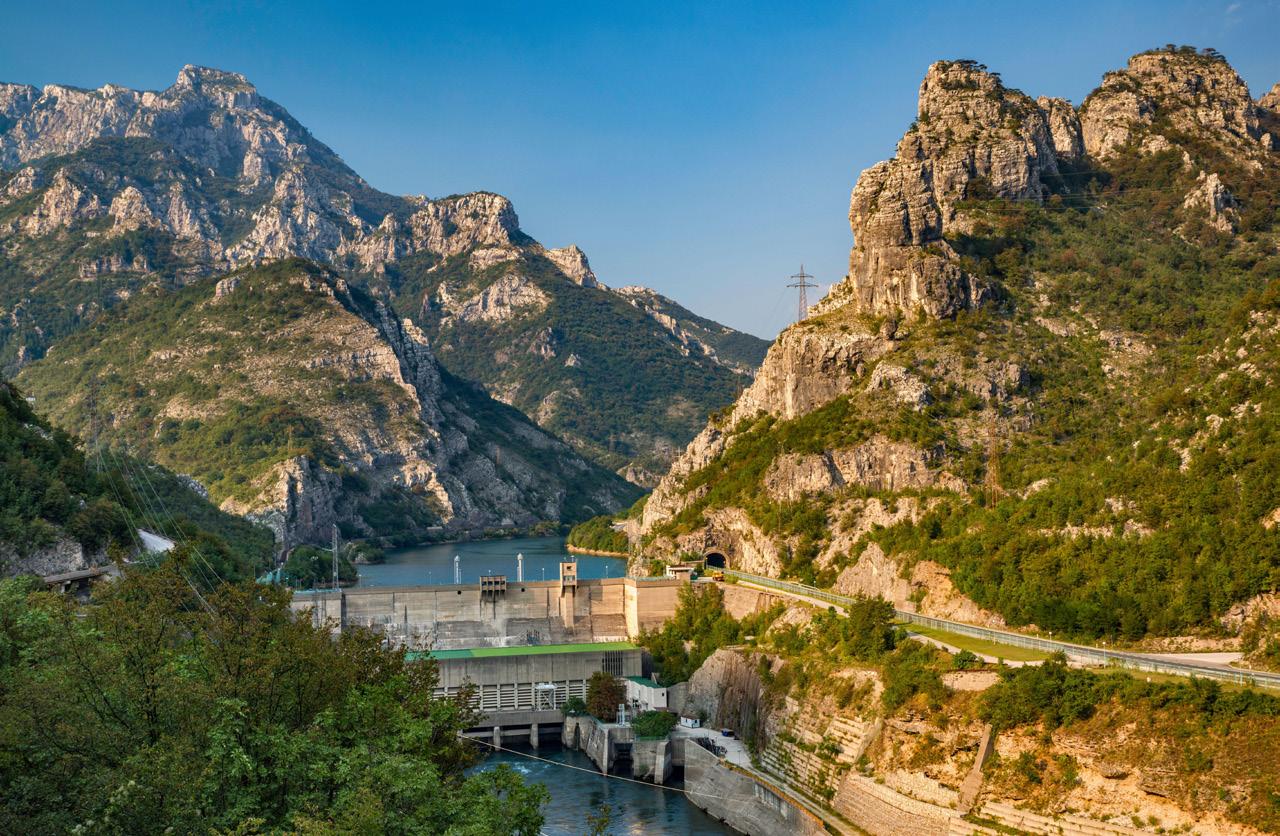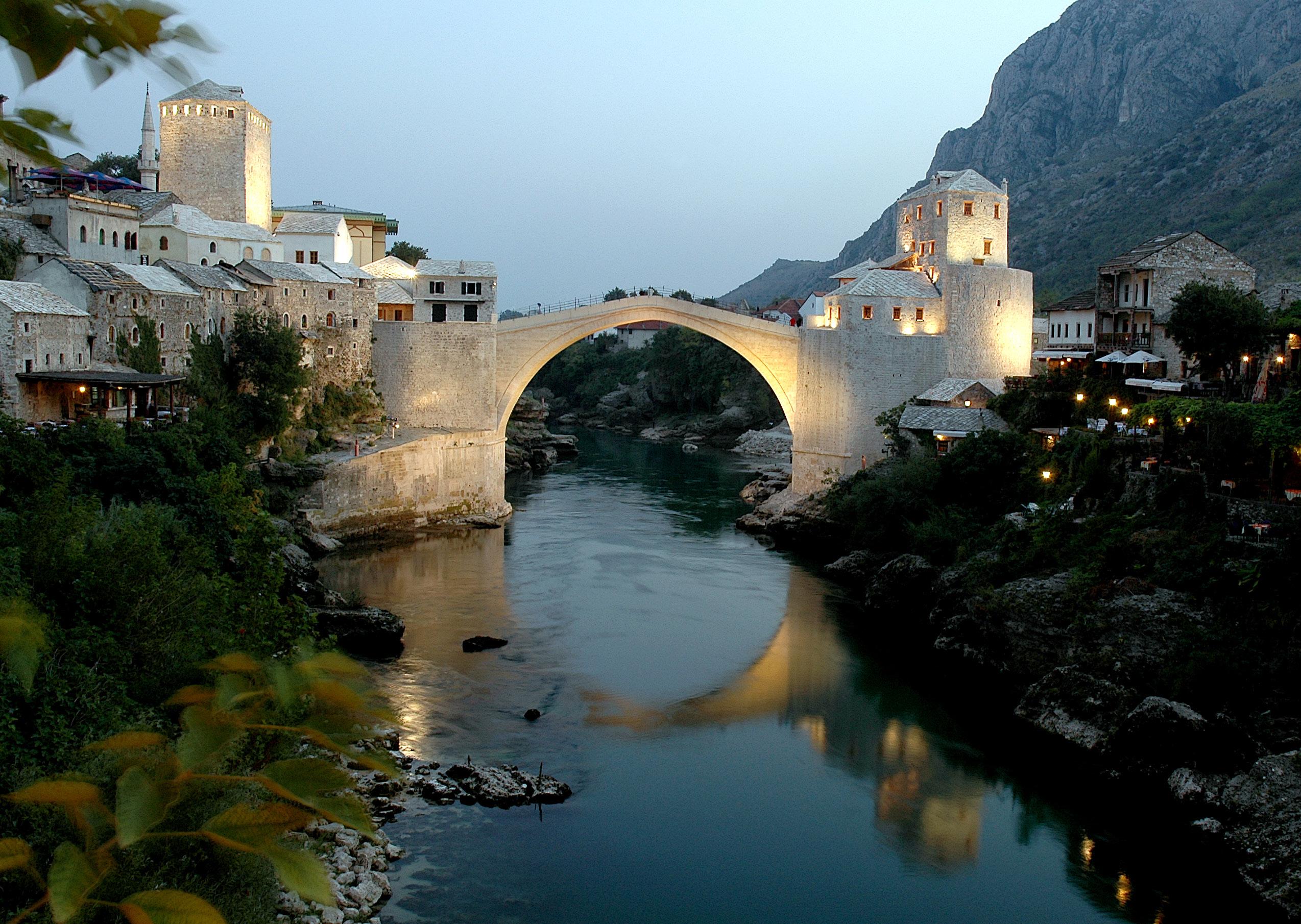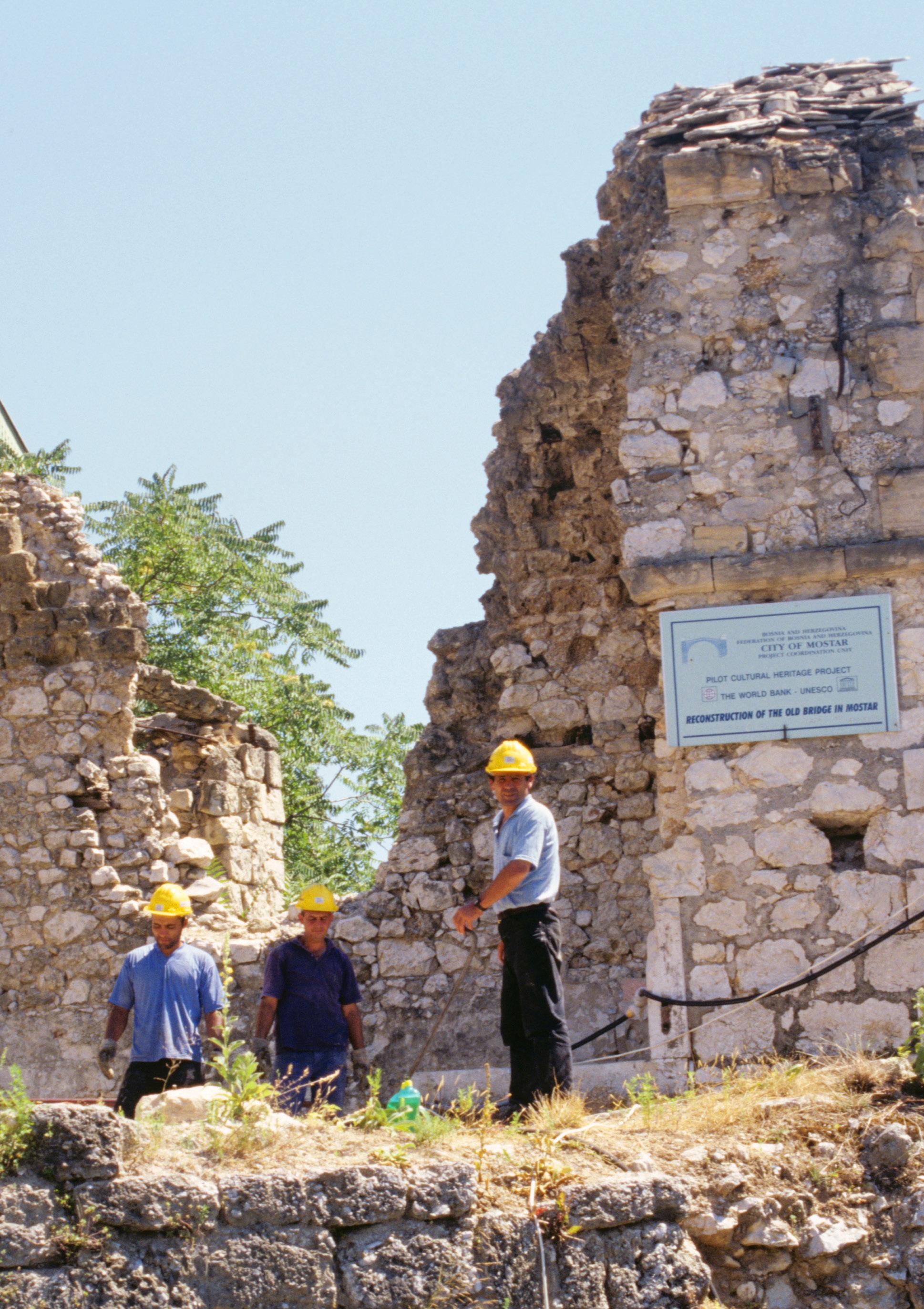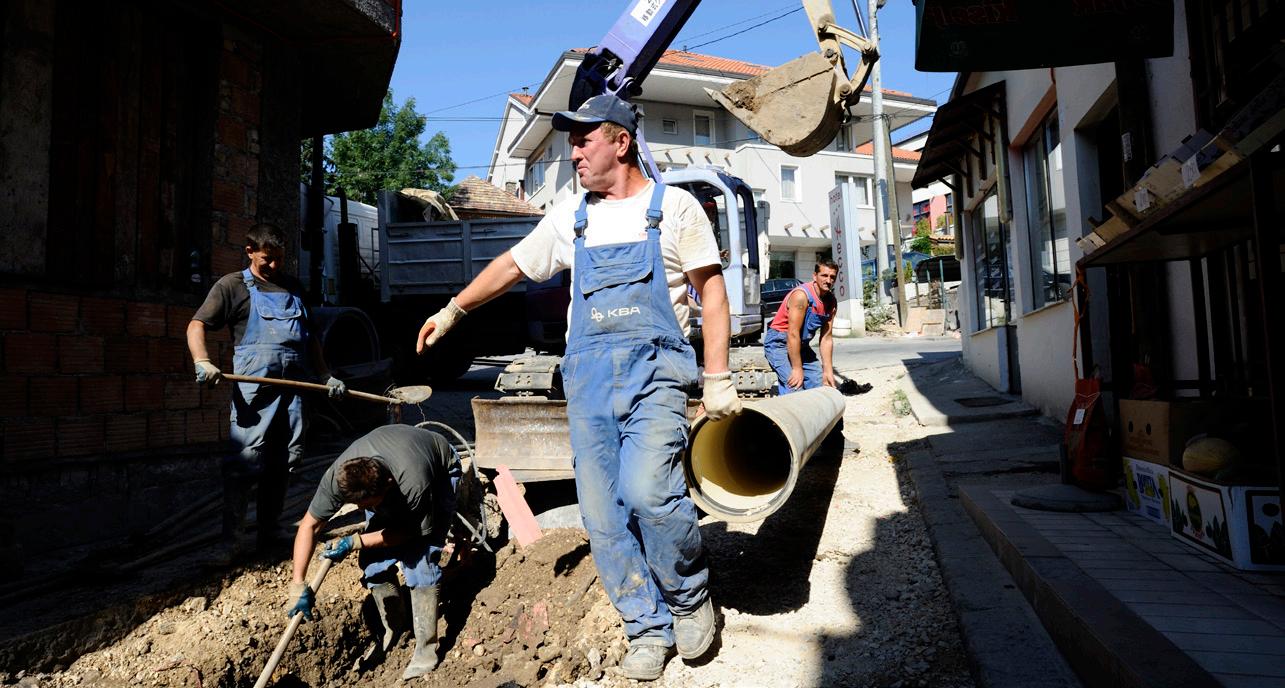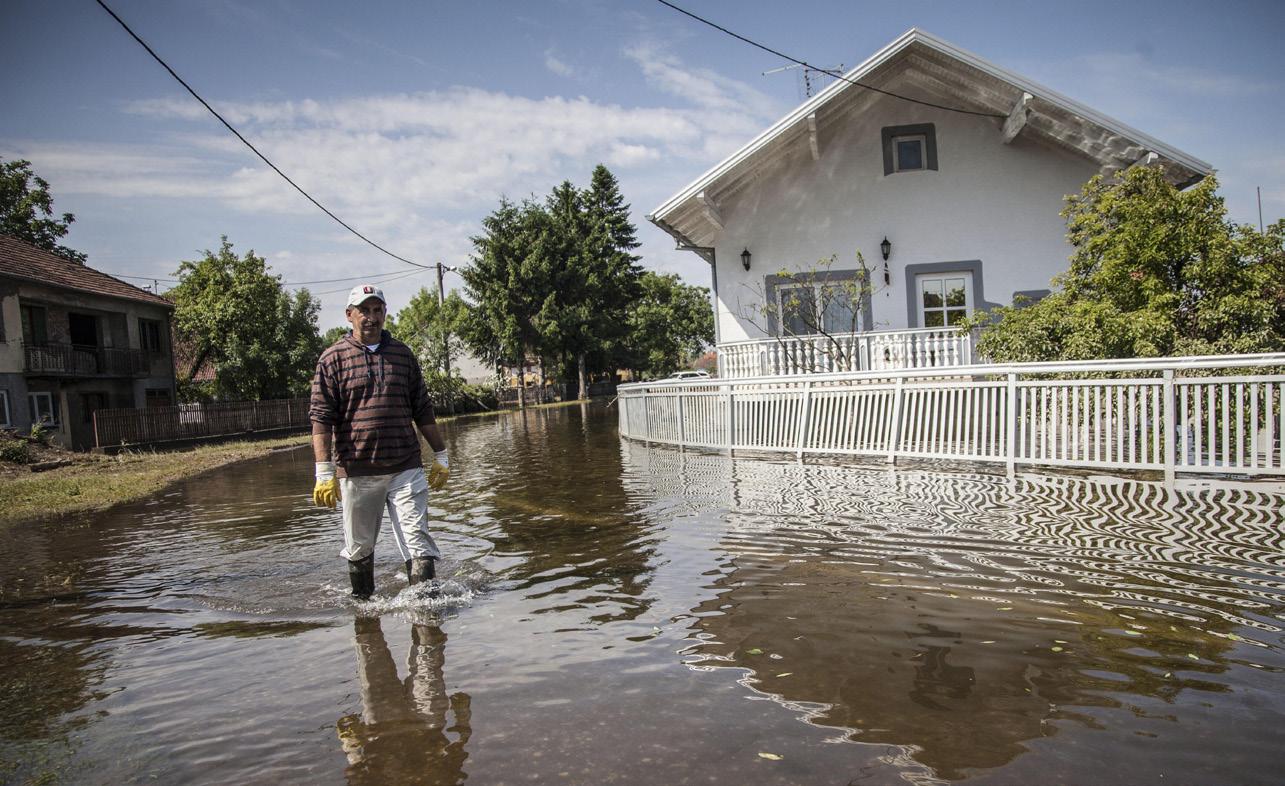THE BEGINNING
The human and economic cost of the war in Bosnia and Herzegovina between 1992 and 1995 was enormous. It is estimated that more than 100,000 people were killed and 2 million were displaced or became refugees—over half the pre-war population.
The war not only decimated the population but also shattered the economy, bringing productive activities almost to a halt. The pre-war gross domestic product (GDP) of approximately US$9 billion plummeted to around US$2 billion, with per-capita GDP decreasing by nearly three-quarters—from about US$1900 to roughly US$500. Of the nearly 900,000 workers employed in 1991, very few retained their jobs postwar. Wages and salaries dropped significantly, pension payments ceased in much of the country, and most of the population was thrust into poverty.
THE TOLL OF WAR 100,000+ lives were claimed
2,000,000 refugees and displaced persons i 75% drop in per-capita GDP
Wartime destruction of the Oslobodjenje Newspaper building in Sarajevo.
Bosnia and Herzegovina also sustained extensive damage to its physical infrastructure. Transport and telecommunication lines, along with power generation and distribution facilities, were particularly affected and required urgent and extensive repairs. Direct war damages were enormous, estimated between US$15–20 billion. Additionally, indirect damage from the lack of maintenance resulted in further billions of dollars in lost productive capacity.
In the immediate aftermath of this human and economic catastrophe, the authorities of Bosnia and Herzegovina collaborated with international partners, including the World Bank Group, to develop a comprehensive plan aimed at economic recovery and reconstruction. This plan focused on addressing four immediate challenges:
I. Stabilizing the macroeconomic situation and establishing institutions for a new economy.
II. Supporting the transition towards a private sector-based market economy.
III. Reconstructing physical infrastructure and facilitating the return of displaced people.
IV. Normalizing the country’s financial and economic relations with the international community, including donors.
“The conclusion of the Dayton-Paris Peace Agreement on December 14, 1995, ended Europe’s most destructive war in the last fifty years. It was the first step towards reconciliation and reconstruction for Bosnia and Herzegovina, a task whose outcome could cement or break the peace process which is yet to be consolidated.”
–WORLD BANK MEMORANDUM, FEBRUARY 1996
From the outset, the World Bank Group played an active role in mobilizing resources and garnering international support to assist Bosnia and Herzegovina in addressing its most urgent needs. The initial batch of immediate assistance programs included projects focused on transport reconstruction, agriculture, and energy sectors.
Signing of the Dayton Peace Agreement.
Rebuilding Bosnia, Bank’s World —WORLD BANK GROUP ARCHIVES
Emergency Recovery Project
Approval Date: March 1, 1996
Total Project Cost:
US$160 million
Closing Date: June 30, 1998
The Emergency Recovery Project was the first World Bank’s operation in Bosnia and Herzegovina. It was conceived to restore and rehabilitate the country’s severely damaged infrastructure, jumpstart productive activities in its war-ravaged economy, and support the most vulnerable populations during the immediate post-war transition period. The project provided credit lines to small and medium-sized enterprises to stimulate the private sector. It also facilitated the repair of government infrastructure and supported the Emergency Social Fund to ensure basic assistance for the most disadvantaged groups. In addition to contributing significantly to the country’s recovery efforts, the project is estimated to have generated nearly 5,000 jobs in Bosnia and Herzegovina. The project mobilized substantial donor resources— of the total project cost of US$160 million, US$45 million came from World Bank trust fund resources, with the remainder from Canada, the European Union, Luxembourg, the Netherlands, Switzerland, the United Kingdom, and others.

Emergency Transport Reconstruction Project
Approval Date: March 29, 1996
Total Project Cost: US$163 million
Closing Date: June 30, 1999
The project tackled the most critical transport challenges in Bosnia and Herzegovina through targeted financing. It successfully helped repair and rehabilitate approximately 180 kilometers of roads, tunnels, and landslips, construct 21 bridges, and reestablish rail services across the country. Additionally, the project laid the foundation for further infrastructure advancements, including paving the way for the Sarajevo airport to accommodate civilian air services.
Signing for the Bosnia and Herzegovina emergency recovery project.
The World Bank financed the rehabilitation and reconstruction of the main roads and all the bridges between Sarajevo and Mostar. —OLJA LATINOVIC WORLD BANK GROUP
“During my visit to Sarajevo in April 1996, I saw the magnitude of the challenge facing the country, and I was profoundly moved by the courage and hope of its people. Working with them and with all our partners, the Bank has already begun to help with the massive task of reconstruction.”
—JAMES WOLFENSOHN, former World Bank President
In April 1996 the President of the World Bank, James Wolfensohn, made a historic trip to Sarajevo calling for an enormous jobcreating program to employ former combatants in Bosnia and Herzegovina.
The strong and visible support of the World Bank’s President was a key element in the Bank’s reconstruction efforts and during project implementation. This support was manifested in an important mobilization of management in the country department and the resident mission.
Thanks to the President’s focus on creating job opportunities for the people of Bosnia and Herzegovina, all sixteen emergency projects, as well as projects in specific subsectors supported by other donors, have included a strong emphasis on generating employment for those most affected by the war.
Emergency Electric Power
Reconstruction
Project
Approval Date: July 30, 1996
Total Project Cost: US$196 million
Closing Date: December 31, 1998
Across Bosnia and Herzegovina nearly 80 percent of electricity-generating capacity was impaired or out of operation after the 1991-95 war, causing major setbacks to economic recovery and creating challenges for residents and businesses. The project was implemented to address these issues by rehabilitating four hydropower stations (Jablanica, Grabovica, Mostar, and Jajce) and three thermal power plants (Tuzla, Kakanj, and Uglejevik). Additionally, the project included the repair of hundreds of kilometers of transmission lines and essential parts of the distribution networks, as well as the restoration of communication and power system control systems. Technical assistance was also provided for engineering services, and studies were conducted on sector restructuring and tariffs. The project was developed and financed jointly with the European Union and the European Bank for Reconstruction and Development, with cofinancing from several bilateral donors.
Former WBG President James Wolfensohn
Grabovica Hydroelectric Power Station —ALAMY STOCK PHOTO
Mostar Bridge Reconstruction Project Funding
World Bank, IDA: $4M
Italy: $3M
Local governments: $2M
The Netherlands: $2M
Council of Europe
Development Bank: $1M
Croatia: $0.5M
The most iconic bridge of Bosnia and Herzegovina collapsed on November 9, 1993, after being targeted during the siege of Mostar.
With the financial backing of a US$12.5 million project funded by the World Bank and various donors, the city of Mostar embarked on a journey to restore its historical symbol. The initiative involved reconstructing the elegant arch and its towers, repairing other damaged monuments, and preserving Mostar’s historic old town.
On April 14, 2003, the first stone of the new arch was laid in a ceremony witnessed by numerous Mostar residents and broadcast globally. The official opening ceremony drew an even larger crowd, with most citizens across Bosnia and Herzegovina watching the event live on state television. Today, the restored bridge attracts an estimated 1.5 million tourists annually, serving as a symbol of reconciliation and cultural heritage preservation.
There were other important participants. The Governments of France and Turkey supported the bridge’s reconstruction with technical assistance and partial funding for the stones, respectively. UNESCO led the effort, ensuring cultural integrity and architectural authenticity. Meanwhile, the Aga Khan Trust for Culture (Geneva) and the World Monuments Fund (New York) played crucial roles in designing and overseeing various components of the project.
The restored Mostar Bridge.
“We, the people of Mostar, do not remember a sadder day. We grieved for it as if it were a loved one. Even though its remains and rocks were in the water, we stood there daily, visiting it, hoping that its reconstruction would start and that we would see it standing tall again. And that happened; the reconstruction began. For us, it was a rebirth of the bridge and of ourselves—a new life.”
NEW PARTNERSHIP WITH BOSNIA AND HERZEGOVINA
On July 19th, 2022, the World Bank Group Board of Executive Directors endorsed a new Country Partnership Framework for 2022–2026 to support Bosnia and Herzegovina’s sustained recovery from the impacts of the COVID-19 pandemic, as well as reforms to support job creation and a greener, more inclusive economy.
Through this framework, the World Bank Group supports reforms in three broad areas: increased inclusive private sector employment; improved sustainable service delivery, and supporting Bosnia and Herzegovina with improving its resilience to climate change. The framework includes a cross-cutting theme of gender, which is aimed at addressing structural barriers that limit economic opportunities for women and other vulnerable groups to support a stronger, more resilient recovery.
PAULA POPOVAC, Mostar resident
Crews begin reconstruction work on the Mostar Bridge.
Alisa Mujkanovic—the founder of the Bogda company, a handicrafts producer from Sarajevo— is one of many business owners who benefited from the Employment Support Project (page 21), which helps address challenges following the COVID-19 pandemic.
“Bosnia and Herzegovina can seize the opportunity to move to a better path of growth—one that leads to shared prosperity and eventual integration into the European Union. We are committed to supporting Bosnia and Herzegovina on its continuing journey to improve its economy and raise the living standards of its people.”
—CHRISTOPHER SHELDON, World Bank Country Manager for Bosnia and Herzegovina and Montenegro
The World Bank Group Country Partnership Framework provides analysis, advice, and financing for implementation of reform programs designed to restore economic growth and job creation. The Framework provided Bosnia and Herzegovina with access to US$750 million of new lending from the World Bank, depending on the country’s demand and progress in reform implementation.
In addition, the International Finance Corporation (IFC), a member of the World Bank Group, aims to crowd in private capital in key sectors by leveraging innovative advisory and investment products, as well as guarantees from the Multilateral Investment Guarantee Agency (MIGA). The new Country Partnership Framework was prepared based on the analysis of Bosnia and Herzegovina’s overall development challenges, the country’s Joint Socio-Economic Reforms Program 2019-2022, and consultations with a range of stakeholders at various levels of government, private sector, civil society, and development partners.
The World Bank Group is working together with Bosnia and Herzegovina to support economic growth, and to facilitate reforms in line with the country’s ambition to join the European Union and reach higher living standards. This could be achieved through:
• A more dynamic private sector able to create good jobs.
• Better quality and efficiency of basic public services, like health, education, access to water or sanitation.
• Investments to build a country’s resilience to climate shocks and natural events.
The World Bank supports the economic development of Bosnia and Herzegovina through:
1. FINANCING
The World Bank finances government programs to support the achievement of country development objectives and support policy and institutional reforms of national and subnational governments by providing budget financing and global expertise. The World Bank also finances public projects to build physical and social infrastructure and develop institutional capacity.
TYPES OF FINANCING:
• Investment Project Financing provides financing to governments for activities that create the physical/social infrastructure necessary to reduce poverty and create sustainable development.
• Development Policy Financing provides budget support to governments or a political subdivision for a program of policy and institutional actions to help achieve sustainable, shared growth and poverty reduction.
• Program-for-Results links the disbursement of World Bank funds directly to the delivery of defined results, helping countries improve the design and implementation of their own development programs and achieve lasting results by strengthening institutions, enhancing systems, and building capacity.
Over two kilometers of the primary and secondary waste water networks in Sarajevo have been repaired or rehabilitated.
2. KNOWLEDGE
The World Bank undertakes analytical and advisory activities to inform country, regional, and global development agenda in line with its mission to end extreme poverty and boost shared prosperity on a livable planet.
TYPES OF KNOWLEDGE PRODUCTS:
• Advisory Services and Analytics are non-lending activities that help countries or audiences advance a development objective. Through knowledge products, the World Bank supports the design or implementation of better policies, strengthens institutions, builds capacity, informs development strategies or operations, and contributes to the global development agenda. Knowledge outputs include analytical reports, policy notes, hands-on advice, and knowledge-sharing workshops or training programs.
• Reimbursable Advisory Services (RAS) are provided in response to a request from, and paid for by, the recipient of the service (client), under a legal agreement. In providing RAS, the Bank’s purpose is to expand the options available to member countries of all income levels, including those that have graduated from the Bank. RAS clients can be central governments; subnational governments; state-owned enterprises; non-governmental and other not-for-profit organizations (such as chambers of commerce); and multilateral institutions, including development banks and regional organizations.
• Core Analytics is country-level diagnostic reports underpinning country engagements. The group includes the following five diagnostic reports:
» Country Economic Memorandum focusing on prosperity and key economic sectors.
» Country Private Sector Diagnostic focusing on specific opportunities to increase private investment.
» Poverty and Equity Assessment focusing on core poverty and inequality issues.
» Public Finance Review focusing on a country’s revenues as well as expenditures.
» Country Climate and Development Report focusing on adaptation and mitigation and linkages between climate change and development outcomes.
In addition to the support provided by the World Bank, the International Finance Corporation (IFC), the private sector arm of the World Bank Group, aims to foster the development of higher value-added, exportoriented industries in the country by removing barriers to investment. IFC is supporting the country`s private sector through improving competitiveness, strengthening connectivity, and boosting investment in renewable energy sources. IFC executes its mission through strategic investments in private enterprises and providing advisory services.
“The World Bank, together with donors, has invested over $3 billion in Bosnia and Herzegovina in the past 30 years through the implementation of around 120 projects. This is very significant. It is important to note that over 60 schools, 18 hospitals, and over 500 kilometers of road network have been constructed, including tunnels and over 50 bridges. The truth is best expressed in numbers.”
Country Economic Memorandum
—BISERA TURKOVIĆ, FORMER FOREIGN MINISTER OF BOSNIA AND HERZEGOVINA
Left to right: Axel van Trotsenburg, WBG Senior Managing Director; Bisera Turković, former foreign minister of Bosnia and Herzegovina; Bo Li, IMF Deputy Managing Director.
Floods Emergency Recovery Project
Approval Date: June 30, 2014
Total Project Cost:
US$100 million
Closing Date: June 30, 2019
In the spring of 2014, Bosnia and Herzegovina experienced unprecedented rainfall that caused devastating floods. The natural disaster claimed the lives of 20 people, forced 90,000 to flee their homes, and impacted over 1 million individuals. The damage to the country’s infrastructure was estimated at nearly 15 percent of its GDP.
Facing the aftermath of this catastrophe, the government sought assistance from the World Bank. In just 20 days, the World Bank developed a project to address the urgent needs created by the disaster. As a result of this intervention, more than 840,000 people benefited from a variety of interventions and investments. Over 58,000 households had their access to clean water restored, while 10,000 rural households received agricultural supplies and equipment. Additionally, 316 kilometers of roads, 33 bridges, and 15 public facilities, including schools, were repaired, or rebuilt. These efforts significantly contributed to helping communities rebuild stronger and resume their normal lives.
Employment Support Project
Approval Date: January 5, 2017
Total Project Cost: US$97 million
Closing Date: April 1, 2022
In response to the high and persistent unemployment rates, Bosnia and Herzegovina established a goal to increase access to the labor market and boost formal private-sector employment— especially for youth, the long-term unemployed, and women. This required significant labor market reforms, including the enhancement of existing programs and the improvement of labor office efficiency in assisting job seekers. The World Bank’s project encompassed support for various initiatives, including wage subsidies, on-the-job training, support for self-employment, and improved services for both job seekers and employers. As a result of these efforts, tens of thousands of individuals in Bosnia and Herzegovina were able to secure employment and gain access to improved services provided by the country’s employment programs.
Heavy rainfall in the spring of 2014 forced 90,000 residents to flee their homes. —ALAMY STOCK PHOTO
Elma Dzananovic, head of the Mama Burgers fast food restaurant, added 10 employees with help from the Employment Support Project.
BANK PHOTO

To streamline administrative procedures and enhance business efficiency, Bosnia and Herzegovina embarked on a comprehensive project to digitize business registries in court archives and introduce integrated and online business registration. IFC’s Local InvestmentFriendly Environment (LIFE) program, launched in 2016 in partnership with the UK Aid and Swiss State Secretariat for Economic Affairs SECO, played a pivotal role in this transformation. The project focused on digitizing decades-old paper records, making them accessible online to businesses and legal practitioners. By integrating scanned documents into an online registry, the project helped introduce an integrated online registration process that enabled quicker processing of business requests, reduced bureaucratic delays, and ensured the integrity of records. These reforms attracted significant new investments and created numerous jobs, contributing to the private sector’s growth and competitiveness. As a result, Bosnia and Herzegovina has become more attractive to both domestic and foreign investors, facilitating a more dynamic economic landscape.
CURRENT PORTFOLIO
and
US$50M
US$504.8 million
9 projects
Local InvestmentFriendly Environment (LIFE) Program
Approval Date: November 2015
Total Project Cost:
US$7.7 million
Closing Date: September 2023
US$65.3M
US$504.8 million
World Bank’s total net commitment to Bosnia and Herzegovina
“We are honored to celebrate the 30th anniversary of our partnership with Bosnia and Herzegovina. Since the country recovered from one of the deadliest conflicts in modern European history, we have stood by its people every step of the way. Bosnia and Herzegovina aspires to join the European Union and is advancing reforms for economic growth and social development, energy transition, protection of natural resources, and public sector efficiency and accountability. We are committed to continuing to work together to achieve these goals and to support the country in addressing its most pressing development challenges for the benefit of all its citizens.”
—ANTONELLA BASSANI, Vice President of the Europe and Central Asia Region at the World Bank
records have been digitized with help from IFC.
worldbank.org/bosniaandherzegovina




